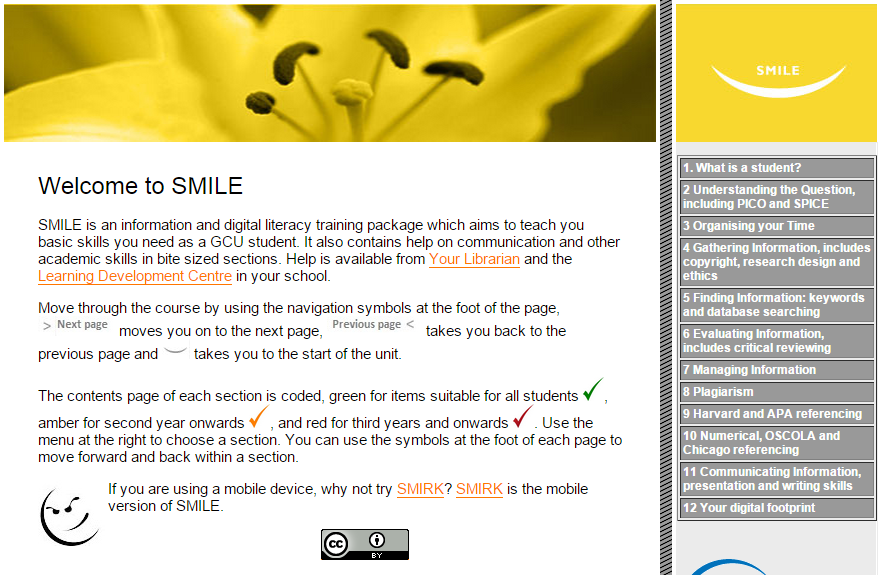In this case study, Marion Kelt tells us about SMILE and SMIRK from Glasgow Caledonian University Library. SMILE is an online information literacy and communication skills training package aimed at undergraduates and MSc students. SMIRK is a mobile-friendly version of SMILE. Later this year, both will be amalgamated into a new, more powerful, mobile friendly version of SMILE.
Both are built using Dreamweaver and can be modified and updated using any web editor. SMIRK uses the JQuery function of Dreamweaver (available in Adobe Creative Suite 6) which is easy to learn – YouTube videos are available!
Most of SMILE and SMIRK is licensed CC-BY (Creative Commons Attribution only), however some sections do vary. This is because additional material has been added over the various versions in response to user demand. These sections have carried forward the licensing of the original material.
The original version of SMILE was developed as a JISC project by Imperial College, Loughborough University and the University of Worcester. It uses audio, video and web pages. We have tailored it using a combination of our own materials and OERs. SMILE was then mapped to GCU’s 21st Century Graduate Attributes, the CBI (Confederation of British Industry) graduate attributes, and the National Information Literacy Framework Scotland and those in The Future of Undergraduate Psychology in the United Kingdom. The mapping process showed some gaps in the subject coverage, as did a series of presentations to lecturing staff. In response to this, we added two new sections: “Your Digital Footprint” on web identity and security and “What is a Student” which aims to help new students transition into HE. Lecturers wanted more information on referencing (we added several new styles as no one system is in use across GCU) and communication and writing skills. This content was adapted from OERs from a wide variety of sources!
The original files were delivered on a data stick, and edited using Dreamweaver. The original team was made up of three library staff, which dropped down to one as staff were re-deployed. The remaining staff member developed the resources alongside her other work on the library web site and other projects. No external funding was made available. Internal funding was limited to a one day Dreamweaver training session for the three staff and the provision of non-GCU standard Dreamweaver software. The rest of the university was using the Terminal 4 content management system and standard templates.
SMIRK was developed in response to student use of a wide variety of mobile devices and the need for a resource that worked well and quickly on them. This involved rewriting content and restructuring menus. This was an advantage as students found that the SMILE menu system was not intuitively obvious and hard to navigate.
SMILE was originally made available on Blackboard as the chief librarian at the time thought that better user statistics would be available. This proved not to be the case. There was also the issue that distance learners found BlackBoard hard to use due to the university requirement to change password every three months. As SMILE and subsequently SMIRK were developed and shared as OERs, there was no need to protect them behind a login system and so it was decided to make them available to a wider audience on the open library web site. This meant that more reliable and easier to obtain user statistics would be available via Google analytics. SMIRK was made available in this way from its launch, so more reliable information is available.
Feedback was obtained using Google forms embedded at the end of each section of SMILE. The feedback was collated into spreadsheets and many of the suggestions have been incorporated into SMIRK.
The original version of SMILE was designed as a sequential course, with the option of using individual units on a standalone basis. Users at GCU did not use it in this fashion, preferring to go directly to the short sections they needed at the time they were required. To cater for this, and to address the problems with the structure and navigation, lecturers were provided with a set of direct links to the most popular sections which were embedded into blackboard modules by the librarian. This helped lecturers provide blended learning resources in their modules and allowed them to direct students to the appropriate sections as pre-work and backup to library training and relevant modules.
- Kelt, M.D. (2003) Web based tutorials at Glasgow Caledonian University. Assignation Vol. 21 (1), pp.32-34.
- Kelt, M.D. (2012) SMILE: making the most of other people’s work – not reinventing the wheel. Conference paper. 101st Deutscher Bibliothekartag: Bibliotheken – Tore zur Welt des Wissens (101st German Librarian’s Conference: Libraries – the Gateways to Knowledge). Hamburg. May 2012. https://opus4.kobv.de/opus4-bib-info/frontdoor/index/index/year/2012/docId/1076
- Kelt, M.D. (2012) Developing SMILE using OERs and existing resources at Glasgow Caledonian University Journal of Information Literacy 6 (2), 135-137
- Kelt, M (2015) SMIRK–developing a new mobile resource from an existing project Library Hi Tech News 31 (7), 16-19



